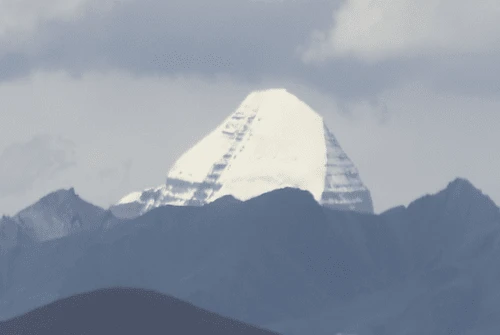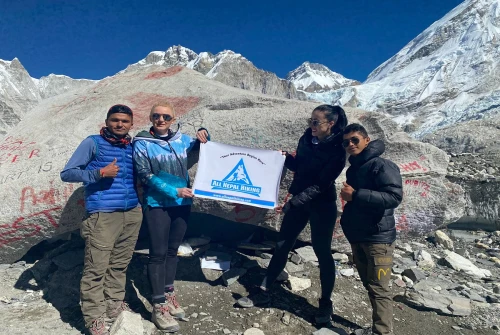Dreaming of walking through the majestic Himalayas to the foot of the world’s tallest mountain? The Everest Base Camp Trek is not just one of the most famous treks in Nepal it’s one of the greatest trekking adventures in the world. Each year, thousands of trekkers from around the globe make their way to the Khumbu region in pursuit of awe-inspiring views, cultural immersion, and personal achievement.
But why is the Everest Base Camp (EBC) Trek so special and why should you do it? Here are the top 10 reasons why you’ll love and should definitely do the Everest Base Camp Trek, whether you're a first-timer, a seasoned hiker, or simply a dreamer in search of something bigger.
Stand in the Shadows of the World’s Tallest Mountains
There’s nothing quite like the feeling of standing face to face with Mount Everest (8,848.86 meters / 29,031.7 feet) the highest point on Earth. During the Everest Base Camp trek, you’ll walk alongside the most legendary peaks in the world, including Lhotse, Nuptse, Pumori, and the dramatically beautiful Ama Dablam, which rises like a spire above the Khumbu valley.
From the famous viewpoints of Kala Patthar (5,545 meters) and Gorakshep, you’ll witness 360-degree Himalayan panoramas that are simply beyond words. These locations offer some of the best Everest views without climbing the mountain itself, especially at sunrise, when golden light illuminates the snow-covered summits.
But these mountains are more than just natural wonders they are deeply spiritual symbols in Sherpa and Tibetan Buddhist culture. Locals revere Everest as “Chomolungma” (Mother Goddess of the World), and Ama Dablam is regarded as a sacred feminine figure that watches over the region. Along the trail, you’ll see colorful prayer flags, mani walls, and chortens, all built to show respect to the divine nature of these peaks.
The combination of natural grandeur, sacred meaning, and photographic beauty makes this part of the trek unforgettable. It’s not just a physical journey, it’s a humbling experience that connects you to the Earth, the sky, and the people who have lived in harmony with these mountains for centuries.

Walk in the Footsteps of Legends
The Everest Base Camp trek is more than just a path through stunning landscapes, it’s a journey steeped in mountaineering history. You’ll be following the footsteps of pioneering climbers like Sir Edmund Hillary and Tenzing Norgay, who made history in 1953 by achieving the first successful summit of Mount Everest. Trekking this trail connects you to a legacy of courage, determination, and human spirit.
As you hike through the Khumbu region, passing through iconic Sherpa villages like Namche Bazaar and Dingboche, you experience the same route that countless adventurers and climbers have used for decades to prepare for the ultimate challenge: Everest’s summit.
The trek culminates at Everest Base Camp (5,364 meters), the bustling hub where climbers gather before their ascent. Here, surrounded by vibrant prayer flags fluttering in the wind, rugged glaciers, and the towering peaks of the Khumbu Icefall, you’ll feel the profound energy of mountaineering history.
Local Sherpas often welcome trekkers here, sharing stories of famous expeditions and their own experiences. It’s a humbling reminder of the mountain’s power and the human stories intertwined with it.
This deep connection to the past and present makes the Everest Base Camp trek more than just a hike ,it’s stepping into a living, breathing chapter of Himalayan adventure.
Experience the Peace of Sherpa Culture and Himalayan Buddhism
The Everest Base Camp trek is as much a cultural journey as it is a trek through breathtaking mountains. The Khumbu region is home to the resilient Sherpa people, whose lives are deeply intertwined with Tibetan Buddhism and a profound respect for nature.
As you pass through traditional Sherpa villages like Namche Bazaar, Tengboche, and Pangboche, you’ll experience a way of life that has remained largely unchanged for centuries. These settlements are dotted with colorful prayer flags, mani stones, and chortens (Buddhist shrines), all reflecting the community’s spiritual devotion.
One of the trek’s most spiritual highlights is the Tengboche Monastery, nestled high above the valley with the majestic Ama Dablam peak towering behind it. This centuries-old monastery serves as a center of prayer and meditation for Sherpa monks. If you time your visit right, you can witness monks performing traditional rituals and chanting prayers a mesmerizing and peaceful experience that offers insight into the region’s rich spiritual heritage.
The Sherpas’ lifestyle is closely connected to the land, marked by farming, yak herding, and hospitality. Spending time in these villages, you’ll notice how the locals balance modern trekking tourism with ancient customs, providing an authentic glimpse into Himalayan mountain life.
This cultural immersion adds depth and meaning to the trek, reminding you that the Everest region is not just a natural wonder it’s a living, breathing community rooted in tradition.

Stay in Cozy Tea Houses and Experience Genuine Hospitality
One of the most beloved features of the Everest Base Camp trek is the unique tea house culture. Unlike camping treks, this route is dotted with numerous locally run lodges and guesthouses where you can rest, eat, and connect with others at the end of each day.
These tea houses offer simple but cozy accommodations, often heated by wood-burning stoves, providing warmth after long days on the trail. You’ll enjoy hearty meals like dal bhat (traditional Nepali lentil soup with rice), momos (dumplings), and noodles, fueling you for the next day's adventure.
Evenings are magical here imagine sitting by a flickering fire, sipping a steaming cup of ginger lemon honey tea, and swapping stories with fellow trekkers from all over the world. The shared laughter, tips, and experiences create a powerful sense of camaraderie and community.
This hospitality is deeply rooted in Sherpa traditions of welcoming guests. Many tea houses are family-run businesses that have supported their communities for generations. Staying in these lodges not only offers comfort but also a genuine window into the local lifestyle of the Khumbu people.
The tea house experience transforms the trek from a solitary physical challenge into a warm, social journey filled with connection and cultural exchange.
Challenge Yourself Mentally and Physically
The Everest Base Camp trek is a true test of endurance, strength, and mental resilience. It’s not an easy journey covering roughly 12 to 14 days of trekking, the route takes you from the lush forests of Lukla (2,800 meters) up to the high-altitude viewpoint of Kala Patthar (5,545 meters), with the demanding Everest Base Camp (5,364 meters) as your ultimate destination.
You’ll face long days of walking on rocky, sometimes slippery trails, cold nights in mountain lodges, and the effects of thin, oxygen-deprived air as you ascend higher. Altitude sickness is a real challenge, so proper acclimatization days in villages like Namche Bazaar and Dingboche are essential to safely continue.
But this physical challenge is matched by a powerful mental journey. Every step pushes your limits and builds confidence, patience, and mental toughness. The trek forces you to slow down, listen to your body, and adapt to changing conditions lessons that resonate far beyond the mountains.
Local Sherpas, who have adapted for centuries to life at high altitudes, often serve as guides and porters, offering not only support but inspiring examples of endurance and harmony with nature. Their calm determination can be a beacon on tough days.
Ultimately, the Everest Base Camp trek is more than just a physical adventure ,it’s a transformative experience that strengthens your mind, body, and spirit, leaving you with a lasting sense of achievement and self-belief.
Ever-Changing Landscapes: A Photographer’s Dream
The Everest Base Camp trek offers one of the most diverse and breathtaking natural landscapes in the world. From dense alpine forests filled with towering pine and rhododendron trees to vast high-altitude deserts dotted with hardy shrubs and wildflowers, the scenery transforms dramatically as you ascend.
You’ll trek alongside roaring glacial rivers, cross iconic suspension bridges draped with colorful prayer flags, and pass through serene valleys that look like they belong in a storybook. The famous Dudh Koshi River and the Khumbu Glacier near base camp provide stunning natural contrasts from lush green to icy blue.
Beyond nature, every landscape is steeped in local culture. The fluttering prayer flags represent blessings for travelers, while mani stones carved with sacred mantras line the trails, blending spirituality with the wilderness.
Whether you’re a seasoned photographer or simply love capturing moments, every day on this trek offers new and stunning vistas majestic mountains framed by pristine forests, vibrant rhododendron blooms in spring, and golden sunsets behind jagged peaks.
Your camera (or smartphone) will thank you, and your memories will be framed forever by this ever-changing Himalayan masterpiece.
Witness Rare Wildlife and Biodiversity
The Everest Base Camp trek passes through the spectacular Sagarmatha National Park, a UNESCO World Heritage Site renowned for its unique high-altitude ecosystem and diverse wildlife.
As you journey through this pristine environment, you may spot some of the region’s fascinating animals adapted to life in the Himalayas. Keep an eye out for:
Himalayan tahrs : sure-footed mountain goats that navigate steep cliffs.
Musk deer : elusive creatures known for their distinctive scent glands.
Snow pigeons and colorful Himalayan birds like the danphe, Nepal’s national bird.
Yaks : the iconic mountain “ships” carrying goods and supplies between villages.
For the truly lucky, glimpses of the rare and shy snow leopard or red panda add a magical touch to the trek, though these animals remain mostly hidden in remote corners of the park.
The flora also evolves with the altitude from lush rhododendron forests blooming in vivid pinks and reds during spring to hardy alpine shrubs and lichens that withstand the harsh mountain climate at higher elevations.
This blend of diverse wildlife, changing plant life, and breathtaking mountain scenery makes the Everest region a living, breathing natural wonder and an ecological treasure.
The Thrill of Flying into Lukla One of the World’s Most Notorious Airports
Your Everest Base Camp trek adventure truly begins with the adrenaline-charged flight from Kathmandu to Lukla Airport (Tenzing-Hillary Airport) known worldwide as one of the most thrilling and challenging airport landings. Perched precariously on a mountainside, Lukla’s short runway measures just about 527 meters, with steep cliffs on one side and a drop-off on the other, making every landing and takeoff a heart-pounding experience.
Flying into Lukla isn’t just transportation, it’s part of the journey itself, offering spectacular views of the Himalayan ranges, including glimpses of Mount Everest and surrounding peaks on clear days. As the plane descends through the valleys, you get your first up-close look at the soaring mountains and river gorges that define the Khumbu region.
Once you touch down at Lukla, you’re immediately immersed in the rugged beauty and unique culture of the mountains. There’s no gradual build-up; the mountains embrace you from the very first step. From bustling teahouses to prayer flags fluttering in the breeze, the energy of Sherpa villages and the grandeur of the Himalayas set the tone for the days ahead.
This spectacular entry point perfectly blends excitement, natural beauty, and cultural richness making the Lukla flight an unforgettable start to your trek.

Accessibility Without Technical Climbing Skills
One of the biggest reasons the Everest Base Camp trek attracts thousands of adventurers each year is its accessibility. Despite being one of the most iconic and breathtaking treks in the world, it does not require any technical climbing skills or specialized equipment like ropes, crampons, or ice axes.
If you’re reasonably fit and prepared to hike for several hours a day over 12–14 days, you can take on this journey. The trail is well-marked and supported by a network of tea houses, guides, and porters, making it possible even for trekking newcomers to safely experience the Himalayas.
Proper acclimatization is key, so the itinerary includes rest days in Sherpa hubs like Namche Bazaar and Dingboche, helping your body adjust to the high altitude. Local Sherpa guides play an essential role, sharing their knowledge, ensuring your safety, and enriching your experience with cultural insights.
This combination of manageable physical challenge, logistical support, and local hospitality opens the doors of Himalayan adventure to a wide range of travelers not just mountaineers. Whether you’re trekking solo or with a group, with proper preparation, the dream of reaching Everest Base Camp is within your reach.
A Soul-Stirring Journey You’ll Never Forget
The Everest Base Camp trek is far more than just a physical challenge or a beautiful destination,it’s a transformational journey that touches your soul. Beyond the stunning Himalayan landscapes and towering peaks, it’s the people you meet, the stories you share, and the deep sense of accomplishment that make this trek unforgettable.
For many trekkers, reaching base camp is a spiritual and emotional experience a time to reconnect with nature, reflect on life, and discover inner strength. The simplicity of mountain life, the warmth of Sherpa hospitality, and the grandeur of the natural world combine to create moments of awe and gratitude.
This trek serves as a powerful reminder of how vast, powerful, and beautiful our planet is, inspiring a lifelong love for the mountains and a commitment to preserving these sacred places.No matter who you are, the Everest Base Camp trek leaves a lasting imprint—one that you’ll carry with you forever.
Support Sustainable Tourism and Local Communities
When you embark on the Everest Base Camp trek, you’re not only embarking on a personal adventure you’re also playing an important role in supporting local communities and promoting sustainable tourism in the Khumbu region.
The trek’s economy relies heavily on Sherpa families who run tea houses, work as guides and porters, and operate small shops and restaurants. By trekking responsibly and choosing ethical trekking companies, you help provide livelihoods that empower these mountain communities while preserving their cultural traditions.
Many trekking operators follow strict eco-friendly practices, such as minimizing waste, reducing plastic use, and supporting conservation projects within Sagarmatha National Park a UNESCO World Heritage Site. These efforts protect the pristine natural environment that makes the trek so special.
Your journey contributes directly to preserving the stunning Himalayan landscapes and rich Sherpa culture, ensuring future generations can experience this magical region in all its glory.
Final Thoughts: Why Wait?
If you’re still wondering whether the Everest Base Camp trek is worth the effort, the answer is a resounding yes.
This journey offers far more than just breathtaking Himalayan views. It’s a trek filled with purpose, pride, and perspective, a true test of your strength and spirit. From the thrilling flight into Lukla Airport to the triumphant moment you stand at Everest Base Camp, this adventure will leave an indelible mark on your heart and mind.
Along the way, you’ll connect with the resilient Sherpa people, immerse yourself in ancient Buddhist culture, and witness some of the most stunning landscapes on Earth. Each step will challenge you, inspire you, and ultimately transform you.
At All Nepal Hiking, we’re passionate about guiding travelers safely and respectfully through this incredible journey. Whether you’re a first-time trekker or a seasoned adventurer, we warmly welcome you to join us and experience the magic of the Himalayas firsthand.
So, why wait? Lace up your boots, pack your gear, and prepare yourself for one of the most incredible trekking experiences in Nepal one that you’ll cherish forever.




